Animals that live in lakes all have their unique food requirements, and some are also very specific in where they prefer to dwell in or around lakes in establishing their habitats.
It’s a diverse collection of species too, so they also all have their own interactions with other creatures that share the same ecosystem.
The “animals that live in lakes” list reads like a who’s who of animals found all over the world: Indeed many of them can be found on every continent, from Bats to Pond Skaters.
These animals live in lakes – or dwell at the lakeside – due to their specific dietary requirements or other needs. But all animals that live in lakes share one thing: they’re able to adapt to the habitat changes that occur around them.
Animals that live in lakes include those that hunt near water or animals that simply hang out there. Some stay submerged under the surface of the lake for protection and because it’s a food source. Others use it as a place required within their habitat.
There are so many in fact, that this list could number into the thousands. But here’s a good selection. And for this list, we’re not including the safari species that spend time around watering holes in Africa.
Here’s a quick summary list of the animals that live in Lakes.
Animals That live in Lakes – Quick Reference List
LAKE ECOSYSTEM
50 Animals That Live in Lakes
- Aquatic Salamander
- Painted Turtle
- Flamingo
- Common Carp
- Dragonfly
- Duck
- Frog
- Beaver
- Catfish
- Snail
- Clam
- Crayfish
- Lake Trout
- Lake Herring
- Opossum Shrimp
- Otter
- Scud
- Mayfly
- Leech
- Cricket
- Spider
- Scaup
- Chinook Salmon
- Mink
- Lake Sturgeon
- Ring-Billed Gull
- Egret
- Swan
- Deepwater Sculpin
- Great diving Beetle
- Snapping Turtle
- Snake
- Zebra Mussel
- Caddisfly
- Bat
- Alligator
- Lizard
- Water boatman
- Fiddler crab
- Newt
- Climbing Perch
- Loon
- Sea Lamprey
- Bittern
- Eel
- Pied-Billed Grebe
- Northern Pike
- Cormorant
- Bluegill Fish
- Goose
- Pond Skater
- Muskrat

Animals that live in lakes – and around lakes
Let’s get into the list. See how many you already knew of, or how many you can spot in or around a lake near you.
1. Aquatic Salamander
These flat-headed amphibians, also known as Triturus, are mostly found in lakes in Canada and the United States. They mainly spend their time at the bottom of the lake.
They’re known to camouflage themselves among the vegetation or rocks found on the lake floor.
This is used mainly as a defense mechanism to protect themselves from potential lake predators.
A major portion of their diet consists of small crustaceans, larvae, and water flies. They hunt for food both during the day and night.
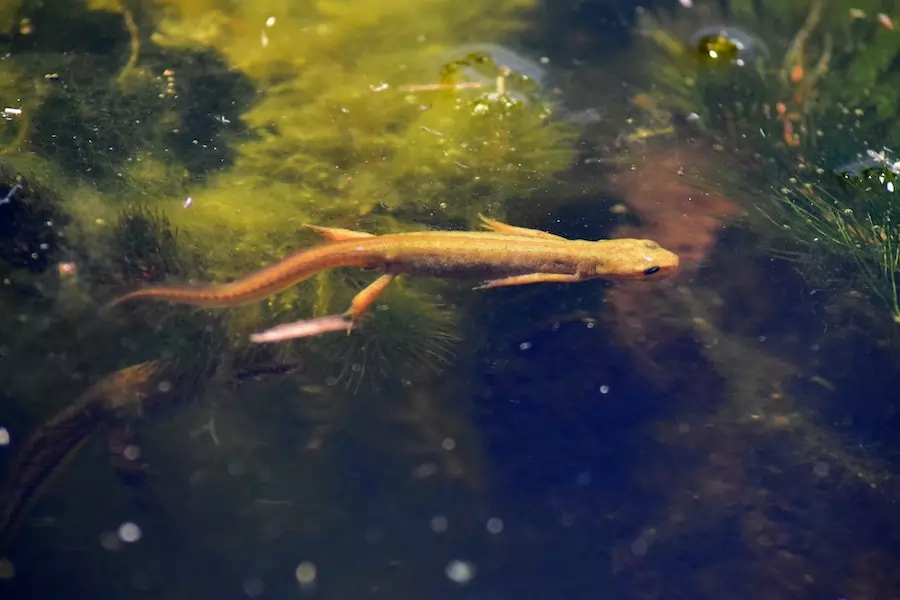
2. Painted Turtle
Found mostly in the lakes of North America, primarily in the United States and Mexico, these turtles also live in places such as wetlands, rivers, ponds, and other low flowing and muddy beds.
As for their name, these animals got their name from the unique red and yellow lines found on their legs and heads.
Moreover, the lines appear as if they are almost painted on their olive-green skins.
Like many other animals that live in lakes, the environment offers food and places of protection.
Painted turtles generally feed on water insects, other crustaceans, worms, tadpoles, and larvae.
To protect themselves from predators such as raccoons and other animals that inhabit the same lake they live in or around lakes, painted turtles will bury themselves in the mud or silt.
Another way for painted turtles to protect themselves is by hiding in and around water plants, rocks, logs, and other animals that shelter them.
When they feel threatened, they’ll take off quickly across the surface of the lake.
Painted turtles are actually one of the slowest animals on Earth. But they are still not slow enough to appear on our Slowest Animals in the World list.
3. Flamingo
Flamingos fall into three species that inhabit America and Europe. Although they commonly prefer saltwater, they have adapted to live in lakes.
They also require large and shallow lakes or similar water bodies to build their nests.
The most astonishing feature of this bird is, of course, its bright pink feathers. They are pink due to their food habits.
These birds also boast long legs that are up to 3 feet in length and a curved beak that helps them to dig for food in the shallow water of lakes.
These pink birds make a beautiful sight when they’re flying with their necks and legs stretched out, especially during sunsets across the lake.
Flamingos also feature on our lighthearted list of the dumbest animals in the world.
4. Common Carp
There are naturally lots of fish that might dwell in lake environments. And we will not be going through all of them. But we will be adding one or two to the list, and here’s a good example of one.
The common carp is scientifically known as Cyprinus Carpio, and is a type of freshwater fish.
These fish are often domesticated as popular additions to aquariums. In their natural habitat though, they prefer to live in lakes and ponds, especially those in East Asia.
Their body is mainly made up of red, gold, and white colors. Some also have black, blue, silver, orange, or yellow shades on their skin.
However, regardless of their color, they are one of the more colorful fishes that dwell in lakes.
5. Dragonfly
These insects stay mostly closer to the lake than in the lake itself as that is where their food source lies, and lake habitats make it a healthy environment for them to lay eggs.
Their chosen dwelling habits near the lake also make them excellent anti- pest creatures as their primary food are flies, mosquitoes, and moths.
Dragonflies have the capacity to stay in one place and attack their prey at high speed.
These insects also have great camouflaging abilities. Their semi-transparent wings often blend with leaves, branches, and aquatic plants. Their bodies can change colors too.
Additionally, find out here if dragonflies will bite you!
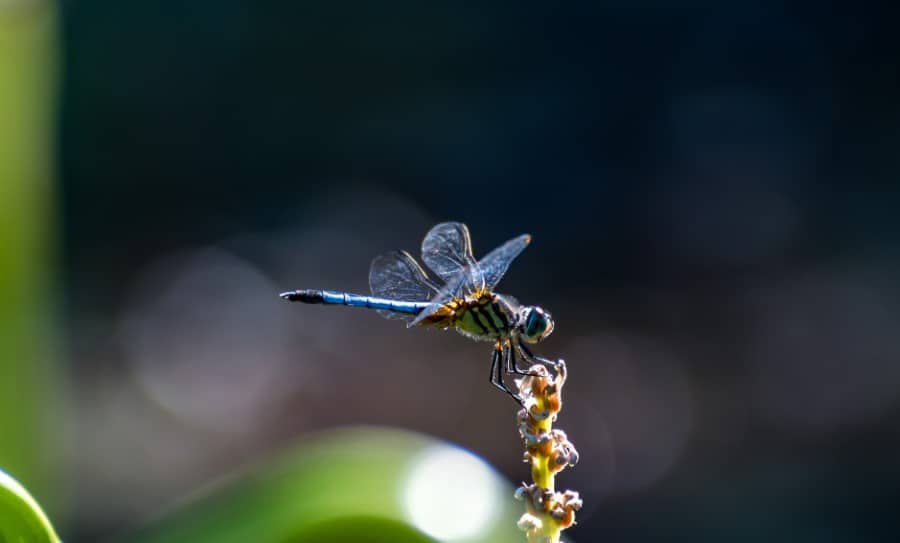
6. Duck
If there is one animal that undoubtedly should make it to the list of animals that live in lakes, it has to be none other than ducks.
Most duck species …and those close to their genera, such as geese and swans, are familiar sights on lakes all around the world. They make their nests at the edge of lakes and mostly among aquatic plants.
Ducks source their nutrients from the insects, fishes, and mollusks who also live in the lake.
One of the main features that allow them to stay in the wet habitat is their feathers. Duck feathers are enriched with a special oil that keeps them away from getting wet.
You can also find out if ducks mate for life, and if Ducks actually do eat fish.
7. Frog
You may have already guessed this name would appear in this list. Yes, frogs are amphibians, and lakes also make up a part of their habitats.
Frogs of all varieties live in lake areas. Including green frogs, wood frogs, American bullfrogs, and others.
They need clean water to survive, so most species of frog are found living in or near freshwater habitats such as lakes, ponds, streams, or rivers. Living in these types of habitats makes it easier for them to catch their prey, such as insects and small fish.
As amphibians, frogs also need to keep their skin moist at all times. This is why frogs can be found in more wet habitats like lakes, ponds, and similar settings.
You might also wonder how long frogs can stay underwater.
8. Beaver
Living in and around lakes, beavers are known to be nature’s own engineers. Building dam-like structures to create the perfect wetland habitat for their home.
These structures are made out of mud, branches, and other natural debris along the lake banks.
When lakes freeze in winter, beavers swim in the water underneath the ice.
Beavers are mainly herbivores and mostly eat the leaves, twigs, barks, and roots of aquatic plants that they can find in and around lakes. Beavers also eat animals when they can catch them, like fish and insects.
9. Catfish
As a type of bottom-feeding animal, these animals live in lakes and other waterways.
They mostly prey on fish found in the lakes, and a variety of prey such as insects, crayfish, leech, frogspawn, and other fish including minnows. They also feed on insects that fall into the water.
At night they usually move toward the shallower sides of the lake and flats adjacent to channels as they offer good fishing spots.
The cuckoo catfish is a fish that can grow to almost 11 inches in length. It inhabits the shallow areas of a lake or river. Cuckoo catfish have also been known to eat ripe fruit from trees that overhang the water.
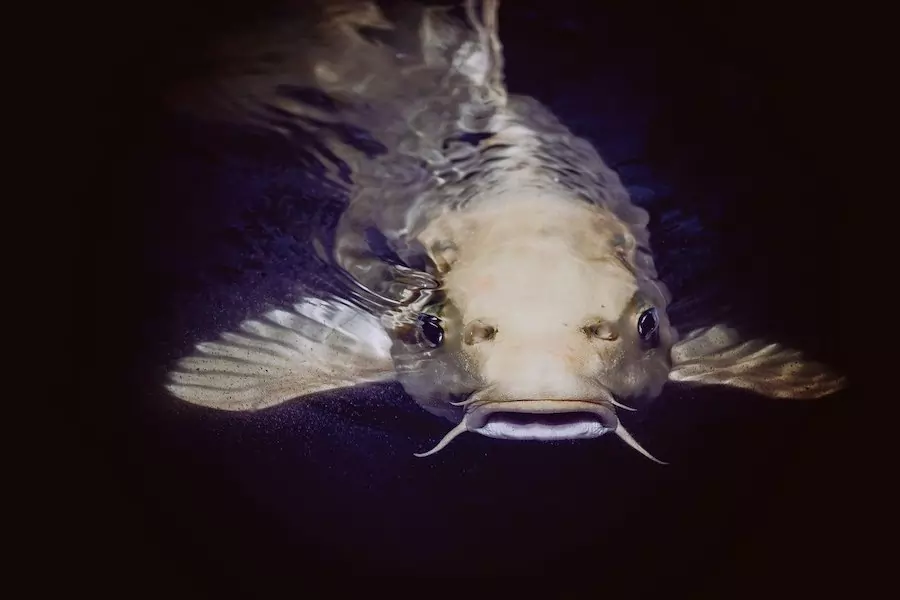
10. Snail
Depending on the species, snails can live in or around lakes.
The bottom sediments or substrates of lakes decide which snail species inhabit there.
They mostly feed on decaying plant matter such as algae which can be found on aquatic plants and rock around the lakes and other water bodies.
They will also lay their eggs in the water that hatch into baby snails.
11. Clam
These animals are another type of bottom feeder that live in the sediment of lakes.
Mostly found in freshwater bodies, they are filter feeders that get their food from the water. Clams use their siphons to filter water and catch food like algae, plankton, or decaying plants.
Their filtering habits help lakes to lower the number of bacteria in them.
12. Crayfish
As a type of freshwater crustacean living in and around lakes. Also known as “crawfish”, crayfish mostly settle their shelters in submerged rocks and logs, or other shelters located around the bottom of lakes.
This habitat positioning helps predominantly as shelter from predators.
Crayfish are omnivores, animals that eat both animals and plants. They catch animals like fish, frogs, and other prey using their claws to protect themselves from predator defenses.
13. Lake Trout
Here’s another classic fish that lives in lakes. A type of cold-water fish that lives in large, deep lakes such as Lake Erie.
Lake trout have a habit of migrating from salt water to lakes before returning for the breeding season.
They mostly prefer to live in lakes that are cold (at least 48-52⁰F) and at a depth greater than 50 Feet.
Some live in lakes that are over 200 feet deep too. Lake trouts are the largest trouts that live in the great lakes.
14. Lake Herring
This fish is also known as the cisco fish. They are very small fish that live in absolutely gin clear water.
Although they can survive in less-than-perfect conditions, they require cold, clean, well-oxygenated water to live and grow. Lake herring do not like to live in lakes with high temperatures.
They also prefer to live in lakes that are deep, or at least 200 feet deep but can survive in water less than 50 feet deep.
15. Opossum Shrimp
These animals can be found in the sand and gravel at the bottom of lakes.
Opossum shrimp are referred to as Mysis relicta and are thought to be native to the Great Lakes.
They are more clear in color, so you can easily spot them in the brackish water found at the shallow ends of lakes. Opossum Shrimp can also be found in seawater.
16. Otter
These animals are found in lakes all over the world. As fish is their main source of food, they usually engage in hunting underwater in lakes as it’s easy to find fish there.
Otters comfortably dwell in any lake and are not specific with the water temperature as long as it provides adequate food for them to thrive.
Also, otters love to swim and play around in the water. They are aquatic animals and can even sleep underwater!
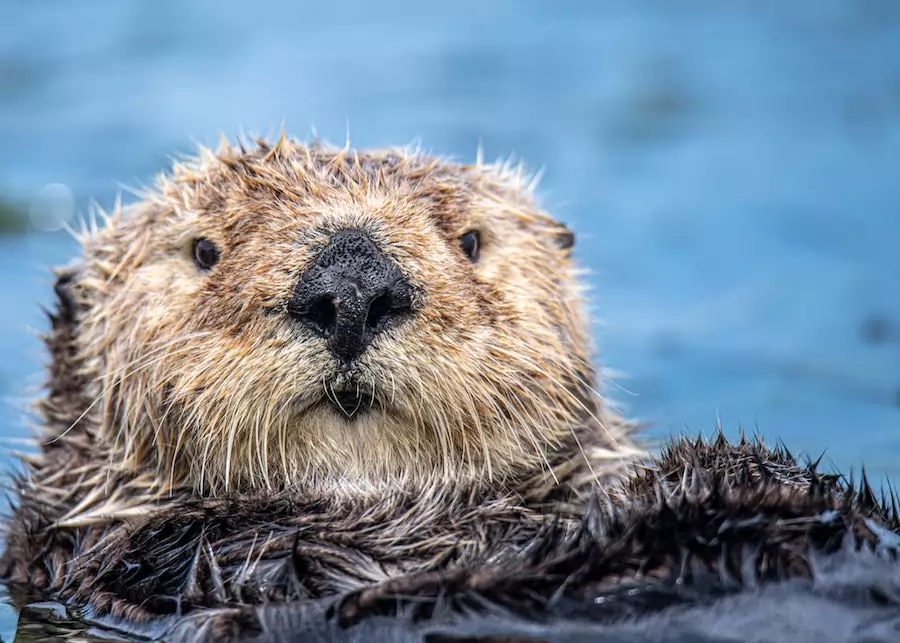
17. Scud
Scud are crustaceans that live in freshwater lakes. They’re tiny animals and look like crayfish although they’re not related to them at all.
Scuds are the size of a fingernail and they’re bottom feeders, living off the organic material that sinks to lake floors. These include plants, algae, and small animals such as insect larvae.
Scud predators include fish, frogs, and aquatic insects.
18. Mayfly
Mayflies are freshwater animals that live in ponds and lakes for most of their lives.
They mostly feed on algae and plants in the water and can be eaten by animals such as fish and frogs. Mayflies are also eaten by animals that live on land, such as birds.
Many animals that live in ponds and lakes are predators of mayflies. Some animals that eat mayflies include fish, frogs, turtles, dragonfly nymphs, predacious diving beetles, water bugs, killer bees, wasps, ants, crickets, spiders, and birds.
19. Leech
Leeches are also animals that live in freshwater lakes. They’re parasitic animals that feed on the blood of vertebrate animals.
They have more than 650 species globally with different feeding habits and life spans.
Like a lot of animals inhabiting the lake, leech also seeks food from fish. They mainly feed on decaying plant material and algae that accumulate at the bottom of lakes.
They are also found living on the lake bed, feeding on animals at the bottom of the lake such as small fish and invertebrates
20. Cricket
There are many animals that live on the edges of lakes, and crickets are one of them.
Crickets can be found in almost all known biomes, including wetlands and lakes, swamps, marshlands, grasslands, forests, mountains, and even deserts.
Crickets also like to live near water sources. They typically hide during the day and come out at night to feed on plants, it’s then that you can often hear that classic cricket chorus.
21. Spider
Another lake dweller is spiders, which typically hide under rocks or other objects on land around the edge of the lake.
In fact, many species of spiders, such as fishing spiders, for example, opt for this environment because their main source of prey is insects, mosquitos, and other insects which are often in abundance on and around lakes.
Some spiders even live under the surface of the water itself and use air trapped in their webs to breathe.
Furthermore, there are thousands of different types of spiders, so it’s not surprising there are some spiders found in lakes.
22. Scaup
Scaup, are diving ducks that spend much of their time at the bottom of lakes.
They can, in fact, be found all over the world. But most of them live in areas where there is a colder climate.
They eat animals such as crustaceans and mollusks that live at the bottom of lakes. Scaups can be found on some of the world’s deepest lakes.
23. Chinook Salmon
Chinook Salmon are anadromous fish. That means they live in the ocean but migrate up rivers to calmer spots, such as lakes, in order to spawn.
They spend their lives in the open waters of oceans and travel thousands of miles each year.
When it’s time for Chinook Salmon to breed, they return to the same place where they were born.
24. Mink
Minks are carnivores and they will eat animals such as muskrats, rabbits, frogs, and birds. You can find the complete mink diet here.
They can be seen in many parts of the world. These animals are aggressive carnivores, and being almost semi-aquatic, they need to live near water sources such as rivers, lakes, wetlands, and swamps.
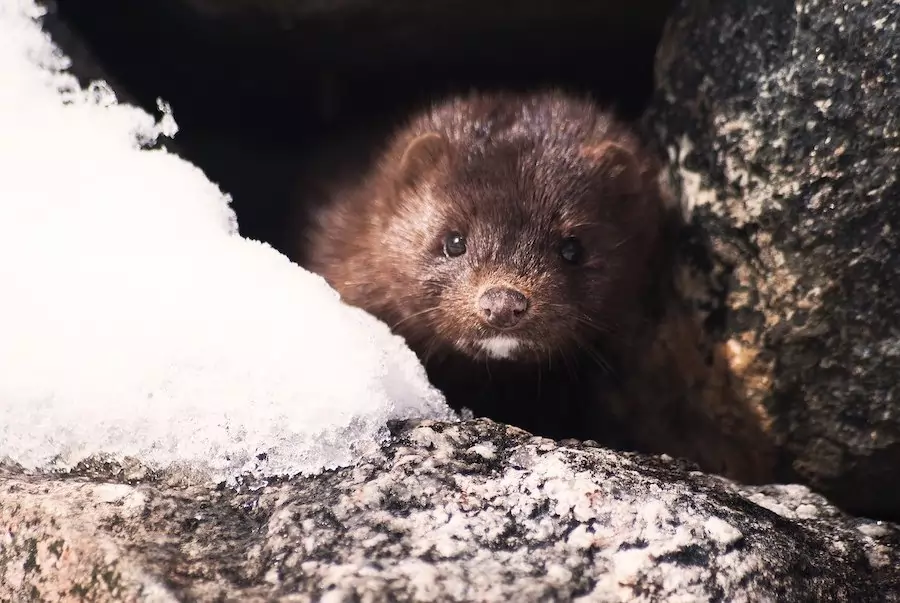
25. Lake Sturgeon
Lake sturgeon are large fish species that migrate between lakes and large river systems. They mostly reside in deep, cold water and can be found in lakes across North America.
Lake sturgeon feed on animals such as snails, clams, crayfish, young lake trout, and insects.
They are an endangered species, mainly due to pollution and dams blocking their migratory routes. They have received some assistance in recent years and are now growing in number once more.
26. Ring-billed Gull
Gulls can be a popular site around all types of water sources, and lakes are certainly one of them. They are often found in groups, called a “raft”.
Ring-billed gulls are an introduced species to North America.
They eat animals such as insects, worms, snails, crustaceans, and fish eggs along with plants and animals near the lakeside.
27. Egret
Egrets are white birds with long necks and legs and white plumes. They’re usually found near water where they fish, but can also be seen on grasslands or on rooftops of urban areas.
Egrets eat fish, small frogs, and other small animals around the lake like mice and lizards. They live in North America, Europe, and Asia.
Egrets build nests out of sticks near the water’s edge. The female egret lays 3-6 eggs in the nest. The eggs hatch and then the baby egrets stay in the nest for about two months.
Egrets are very beautiful birds, and people often watch them in order to observe their graceful movements.
28. Swan
Swans are large elegant birds found around lakes. They are generally found in either pairs or groups of three to five swans.
They stay close to the water where they feed on aquatic plants, animals, and small animals like snails, worms, and other invertebrates.
Swans also migrate for the winter between bodies of water.
29. Deepwater Sculpin
The sculpin is a benthic fish that lives at the bottom of lakes. They are usually found in cold, deep lakes where they live among gravel and stones.
They eat small animals like worms, snails, crayfish, and leeches.
In the world, they are found in most freshwater regions of the northern hemisphere, except the Atlantic coast.
30. Great diving beetle
Great diving beetles are water beetles from the family of Dytiscidae. They’re commonly found in lakes and near water sources on most continents.
Some species are known to grow up to 1.9 inches long. And some varieties of these beetles live in dense undergrowth.
The larvae, as adults, live in stagnant water and live underwater for about three years.
Great diving beetles feed on animals living in the lake like tadpoles, other larvae, and worms such as glass worms.
31. Snapping turtle
We’ve mentioned the painted turtle already. The common snapping turtle is the most common of the species “chelydridae“ of which most are now extinct.
Similar to the alligator turtle, these animals live in ponds, lakes, marshes, rivers, and other wetlands.
Snapping turtles are the largest freshwater turtle in North America. They can weigh up to 45-60 pounds or more than 20 kilograms.
Snapping turtles have a grayish-white shell with dark spots or streaks on it
These animals can live for up to 80 years. They could also communally hibernate together if the water freezes during winter.
With older male turtles, due to their size, they do not need to defend themselves much, and therefore have few predators.
Their formidable shells protect them, and they would seek to hide when they sense the danger near their habitat.
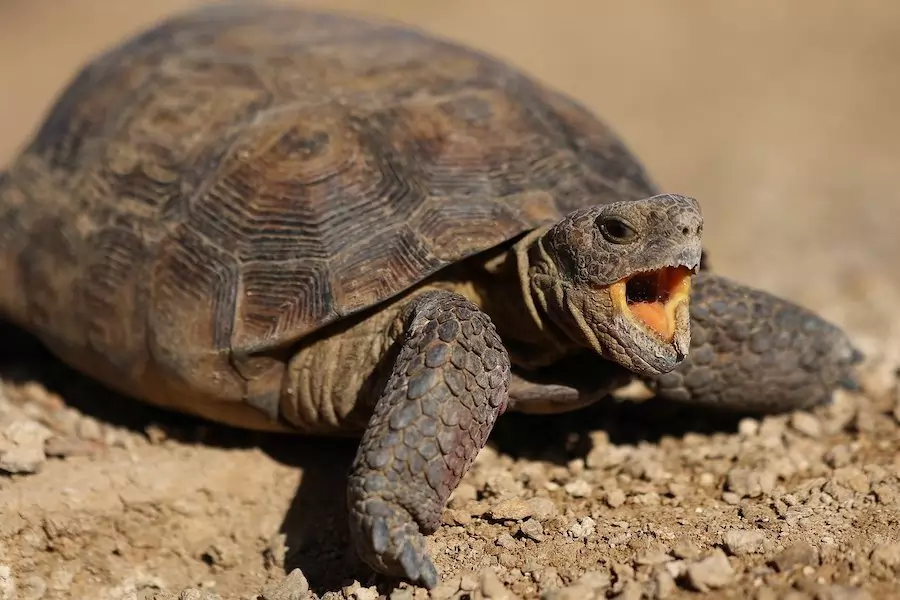
32. Snake
Banded, brown, southern, and northern snakes are some of the more common snakes that live in lakes.
They can be found in water that is both shallow and deep. Most snakes in water prefer relatively clear water and often there’s a lot of surface vegetation
33. Zebra Mussel
Zebra mussels are an invasive, fingernail-sized mollusks found in fresh water in Eurasia. Their name is derived from the dark, zig-zag markings on their shell, which give a striped appearance.
Zebra mussels exhibit filtration feeding behavior which is toxic for the water and other waterborne animals, filtering out algae other animals use to feed on.
They use their byssal threads to attach themselves to any surface – including native mussels. They do this because it is a good way for them to get the nutrients that they need from the water without the risk of being grazed on by animals.
Zebra mussels are primarily found in freshwater because it is the only place they can reproduce. They have now been found in numerous states across North America.
34. Caddisfly
Caddisflies are a type of insect with aquatic larvae and terrestrial adults. There are roughly 14,500 species that have been recognized in the order Trichoptera.
They commonly use their silk filament to attach themselves to rocks or other surfaces.
They do this because they want to avoid being grazed on by animals such as fish and dragonfly larvae, which is a common predatory method for animals in the water.
Adults generally do not feed due to their short lives, but larvae have a variety of feeding habits depending on the species. leaf shredders, algal grazers, or particle collectors from water sources.
35. Bat
Bats can often be found around lakes due to the feeding opportunities that lakes present. There are a number of types of bats that can be found.
They can, in fact, be found in both salt and fresh water but their preferred habitat is the forest that surrounds water sources.
They typically roost in tree cavities during the day and fly out to feed at night.
Fishing spiders can be found in lakes and ponds with abundant vegetation which they use as a place of shelter during the day.
The spider will sit and wait for an animal such as a water strider, mosquito, or midge to land on the surface of the lake whereupon it is grabbed by
36. Alligator
Alligators are freshwater species that live in the slow-moving water of lakes and rivers. They typically live in freshwater environments which have a mucky substrate containing a lot of surface vegetation.
They are also more active during the warmer times of day, however, they are sometimes nocturnal animals too.
Alligators typically live for up to 35 years in the wild. Their numbers have been declining due to habitat loss and illegal poaching.
Similarly, crocodiles are also animals that live in and near water around bodies of water such as lakes and slow-moving rivers.
They can be found all over the world in warm or temperate environments, except for higher regions like mountains and cold areas such as Antarctica.
They eat animals such as turtles, snakes, fish, and other animals that attempt to cross lakes or rivers.
37. Lizard
Lizards are animals of varying species that live in lakes, usually on the bottom of the lake, but sometimes they can be found living around an island for example.
They will also bask out of the water to keep themselves warm by absorbing heat from the sun’s rays – usually early in the day.
Most lizards are carnivorous animals, some are even specialized feeders on ants.
38. Water boatman
Water boatmen (family Corixidae), contain 300 species of insects in the true bug order, Heteroptera.
They earned their name from their boat-shaped and flat bodies and long, oar-shaped hindlegs
The animals can be found in lakes and ponds in Europe and Northern America.
They feed on decaying plants like algae and dead animals, which is why they are also known as “scavengers”.
Their size ranges from 0.1 inches to 1 inch. The water boatman can also be found in rivers, but usually prefer the quiet waters of lakes and ponds.
39. Fiddler crab
Fiddler crabs are smaller than regular crabs and generally don’t grow to more than one inch long.
These animals are known for their one large claw, which is generally only used by males to attract females. The other smaller claw is used for eating.
They can be found in freshwater or saltwater marshes of North America and Asia.
Fiddler crabs can also be found in the African continent, but these animals are actually a different species.
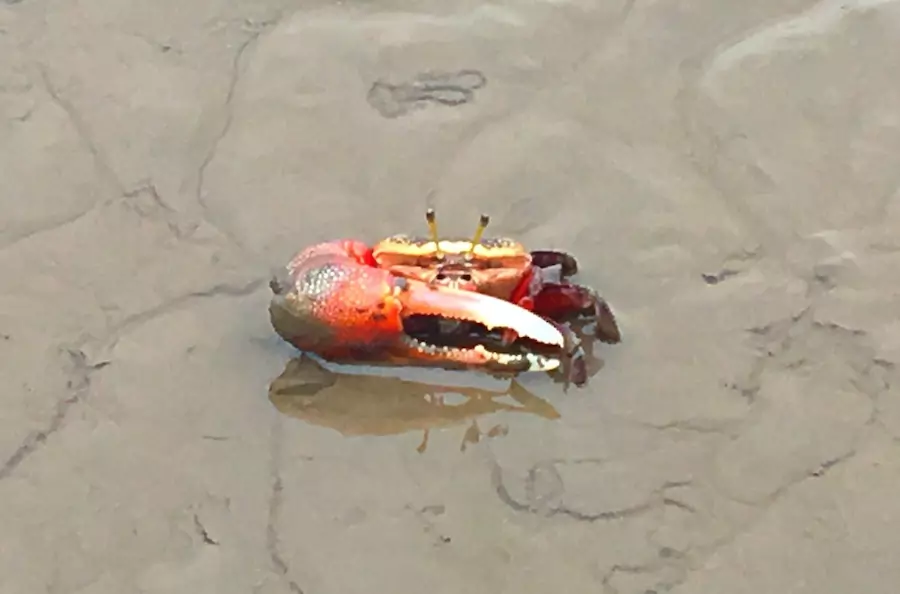
40. Newt
Newts come from a family of animals called Salamandridae and can grow to a length between 4 and 8 inches.
They can be found in both fresh and saltwater and prefer to live in ponds, lakes, and slow-moving streams.
Newts can also breathe underwater for a very long time and some animals even go as far as living their entire lives in the water, but adults can also exist for long periods on land.
Both adult newts and newt larvae inhabit freshwater sources such as lakes, ponds, and marshes.
Slugs, worms, tiny invertebrates, tadpoles, shrimp, insects including aquatic insects, and even amphibian eggs form part of a newt’s diet.
Newts have glands on their skin, which secrete a toxin called tetrodotoxin, which
41. Climbing Perch
The climbing perch, Anabas testudineus, is a species of perch-like fish from the subfamily Anthiinae, part of the family Serranidae.
Climbing Perch swarms can be found in freshwater habitats such as rivers and lakes.
The Climbing Perch can breathe air through its gills, mouth, and through its intestine. The digestive tract of the fish is specially adapted to allow air into its system. Their intestine absorbs oxygen and releases carbon dioxide like a mammal’s respiratory tract would.
42. Loon
Loons are a type of aquatic bird that are expert swimmers. They have lobbed feet, instead of webbed feet. Loons have torpedo-shaped bodies to help them travel through the water more easily.
Loons dive deep in order to catch their prey. Their diet consists of animals such as eels, fish, and frogs which are in good quantities in and around lakes.
43. Sea lamprey
Lampreys are animals that attach to other animals and suck their blood. Once sea lamprey locates a target, it will attach to it and feed on its blood for several days.
Sea lamprey is native to the Atlantic and Arctic oceans but may be found in inland lakes as well.
They live in freshwater or saltwater but prefer shallow areas with slow-moving currents that have many rocks, plants, and animals to prey on. They can be found in rivers, streams, estuaries, and lakes.
44. Bittern
A reed nesting bird, Bitterns live in marshes and wetlands near lakes and rivers.
Bitterns eat animals such as small fish, frogs, grasshoppers, and crickets. as well as water scorpions, crayfish, and small animals found around swamps, marshes, and reed beds.
The bittern is a solitary bird and is very secretive. It tends to be hard to view or study because it spends so much time hiding in dense vegetation.
The “call” of the bittern is also very unique.
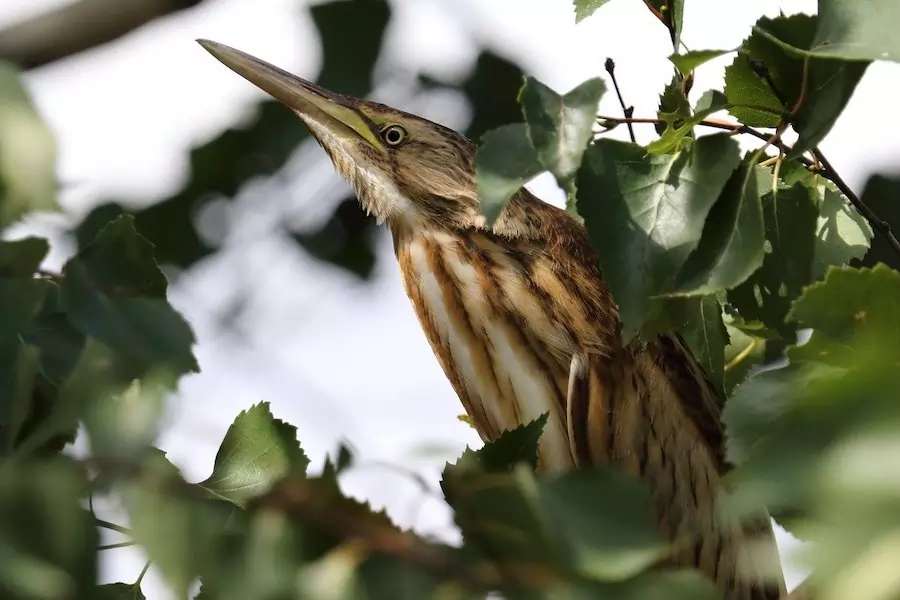
45. Eel
Eels are animals that have snake-like bodies and can be found in lakes, rivers, and marine waters throughout the world.
They eat animals such as insects, fish eggs and larvae, frogs, worms, and leeches.
Eels are native to Europe and North America. They live in oceans but migrate to freshwater rivers and lakes such as the Sargasso Sea, to breed and reproduce.
Eels are also a popular food in a lot of countries.
46. Pied-billed Grebe
The pied-billed grebe is an aquatic bird that is known to feed on animals such as fish, frogs, and salamanders.
Pied-billed grebe is a migratory bird but can be found mainly in North, South, and Central America and the Caribbean.
They inhabit freshwater lakes and ponds, along reed beds and wetlands. They can be found in open seas but prefer still waters.
The Pied-billed grebe is considered a shy bird, it spends much of its time diving for food for up to 30 seconds at a time and will dive towards more dense vegetation areas if it feels threatened.
47. Northern Pike
The northern pike is a type of fish that can live in the deep, dark areas of freshwater lakes and rivers.
They eat animals such as insects, crayfish, leeches, frogs, and other fish including minnows.
48. Cormorant
The cormorant is a type of water-fowl that lives near lakes and rivers and by the sea coast.
They are black birds with long necks and they have long hooked bills. Cormorants are native to many parts of the world including most of North America, Europe, and Africa.
Cormorants are excellent swimmers and divers. They will swim after fish by diving underwater or plunging into the water from a height.
To catch food, most cormorants dive to a depth of up to 25 feet. But some cormorants have been known to dive down to depths of 150 feet to catch a fish.
49. Bluegill fish
Bluegills are fish that belong to the sunfish family Centrarchidae that are native to North America. They are found in clear lakes with sandy or rocky bottoms
Bluegills stay close to the surface of the water because that is where their food sources are. They feed on animals like insects, worms, snails, and other fish nymphs.
50. Goose
The classic goose can be found on the ground near water sources including ponds, rivers, and lakes. They are very good swimmers.
They eat animals like mollusks, crustaceans, insects, and leaves or grasses near the water’s edge.
There are many types of geese that can be found throughout the world and have high populations in Europe and North America.
Here are a couple of bonus animals that live in Lakes…
51. Pond Skater
Pond skaters are insects that live near water. They are very good jumpers and can jump up to three times their body length.
They eat algae, animals like mosquito larvae, and other small invertebrates.
Pond skaters can be found in most parts of the world. They dwell in lakes, ponds, and slow-moving streams.
Pond skaters float on the surface of the water and move by hopping along the surface. They are often mistaken for small spiders.
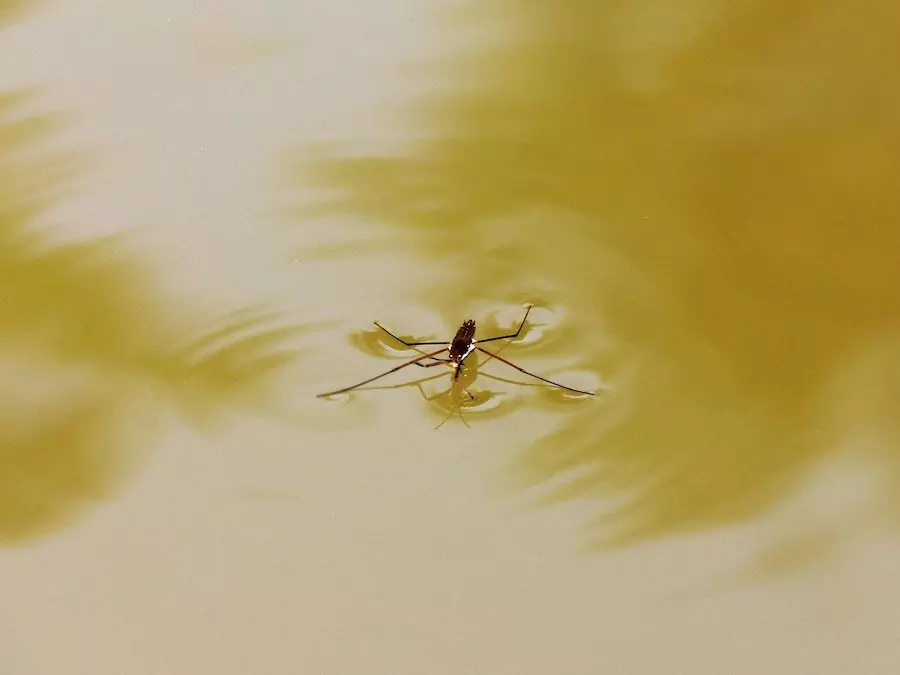
52. Muskrat
The muskrat is a rodent, Ondatra zibethicus, that lives in the North American freshwater marshes and swamps close to water sources including lakes. They have also been introduced into parts of Europe, Asia, and South America.
They are generally nocturnal and have been known to store food below their dens so they can eat their food even if the lake freezes during winter.
Many animals like to eat muskrats including animals such as foxes, wolves, and coyotes. Animals like hawks, eagles, and cougars also eat muskrats.
The average lifespan of a wild muskrat is about two years, but they can live up to six years in captivity. They can breed starting at six months old and can have up to three litters a year, with four to six young per litter.
In summer, muskrats live in dens which are usually underground with only one opening at the surface.
In winter, similar to beavers, muskrats live in lodges that are made by piling up plants and mud. The entrances are both underwater and at the top of the lodge which is inflated from inside by their lungs. Lodges can be about one meter high above the water and under 20 centimeters of mud.
These animals do not hibernate but they can seal themselves inside their dens for long periods during the winter months just to stay warm.
Animals that live in Lakes
We hope this has provided you with an extensive list of animals that live in lakes, and around Lakes. How the lake serves each of these species, plus more helpful information about each type of animal.
There are so many types of insects, fish, and other animals that inhabit lakes and lakeshores that we will have missed, perhaps you can spot some of these yourself and create your own list.
